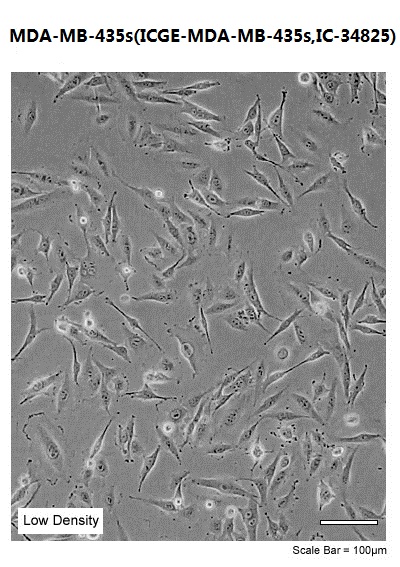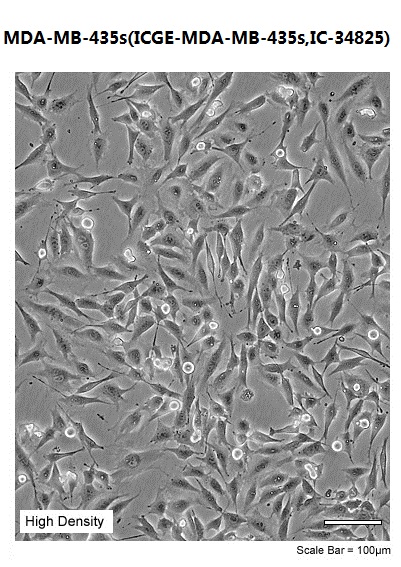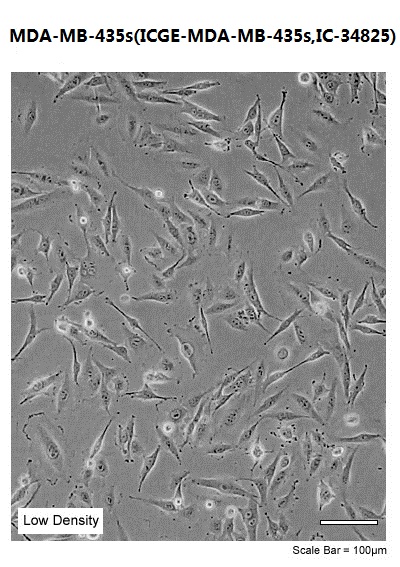


| Permits and Restrictions | |
|---|---|
| Organism | Homo sapiens, human |
| Tissue | previously described as: mammary gland/breast; derived from metastatic site: pleural effusion |
| Cell Type | melanocyte,Melanoma |
| Product Format | frozen |
| Morphology | spindle shaped |
| Culture Properties | adherent |
| Biosafety Level |
1
Biosafety classification is based on U.S. Public Health Service Guidelines, it is the responsibility of the customer to ensure that their facilities comply with biosafety regulations for their own country. |
| Disease | previously described as ductal carcinoma |
| Age | 31 years |
| Gender | female |
| Ethnicity | Caucasian |
| Storage Conditions | liquid nitrogen vapor phase |
| Karyotype |
modal number = 56; range = 55 to 62 The cell line is aneuploid human female (XX), with most chromosome counts in the 55 to 60 range. Normal chromosomes N6, N11, and N22 were absent, while chromosomes N7, N13, N18 and N21 were single. Most of the remainder of normal chromosomes were usually paired, but chromosome N2 was triple. Nineteen marker chromosomes were identified, with most of them formed from structural alterations of the missing copies of the normal chromosomes. Six of these markers involve regions of chromosome N7, while three are recognized as derivatives of chromosome N6. Regions of a third copy of the normal and paired chromosomes N3, N15, N17, N20 are noted in markers M1, M2, M15, and M5, respectively. |
|---|---|
|
|
|
| Derivation |
This cell line was originally described as a spindle shaped variant of the parental MDA-MB-435 strain isolated in 1976 by R. Cailleau, et al. from the pleural effusion of a 31 year old female with metastatic, ductal adenocarcinoma of the breast. However, recent studies have generated questions about the origin of the parent cell line, MDA-MB-435, and by extension HTB-129. Gene expression analysis of the cells produced microarrays in which MDA-MB-435 clustered with cell lines of melanoma origin. |
| Clinical Data |
31 years adult
Caucasian
female
|
| Genes Expressed |
tubulin; actin
|
| Cellular Products | Cellular products: tubulin; actin |
| Tumorigenic | No |
| Effects |
No, in immunosuppressed mice
Yes, in semisolid medium
|
| Comments |
This cell line was originally described as a spindle shaped variant of the parental MDA-MB-435 strain isolated in 1976 by R. Cailleau, et al. from the pleural effusion of a 31 year old female with metastatic, ductal adenocarcinoma of the breast. However, recent studies have generated questions about the origin of the parent cell line, MDA-MB-435, and by extension HTB-129. Gene expression analysis of the cells produced microarrays in which MDA-MB-435 clustered with cell lines of melanoma origin instead of breast [PubMed ID: 10700174, PubMed ID: 15150101, PubMed ID: 15679052]. Additional studies have since corroborated a melanocyte origin of MDA-MB-435, to which ATCC has responded by pursuing its own investigation into the identity of this cell line. The cell line to which MDA-MB-435 is reported to have been cross-contaminated with is the M14 melanoma line [PubMed ID: 12354931 and PubMed ID: 17004106]. |
| Complete Growth Medium |
The base medium for this cell line is ATCC-formulated Leibovitz''''''''s L-15 Medium, Catalog No. 30-2008. To make the complete growth medium, add the following components to the base medium:
|
|---|---|
| Subculturing |
Remove medium, add fresh 0.25% trypsin - 0.53 mM EDTA, rinse and remove. Place flask at room temperature (or incubated at 37��C) for approximately 10 minutes or until the cells detach. Add fresh medium, aspirate and dispense into new flasks.
Subcultivation Ratio: A subcultivation ratio of 1:3 to 1:6 is recommended
Medium Renewal: 2 to 3 times per week
|
| Cryopreservation |
Freeze medium: Culture medium, 95%; DMSO, 5%
Storage temperature: liquid nitrogen vapor phase
|
| Culture Conditions |
Atmosphere: air, 100%
Temperature: 37��C
|


